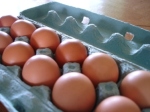 The incredible edible egg. We love them and we fear them. Should we eat more of them, or run from them? Are they giving us heart attacks or are they full of good things to make us strong and healthy? Where’s the truth? What should we do?
The incredible edible egg. We love them and we fear them. Should we eat more of them, or run from them? Are they giving us heart attacks or are they full of good things to make us strong and healthy? Where’s the truth? What should we do?
I want to cut through the propaganda, and give you a high level, short answer and hopefully clear things up for you a bit. If you want to know more, there are plenty of articles, stories and research papers out there to keep you reading the rest of your life.
The spark for this post was a Facebook poster showing the inside of two boiled eggs. One had a deep golden yolk, captioned, ‘organic’. The other was light yellow, with those familiar green hues we’ve all become familiar with from traditional boiled eggs, and captioned, “gmo”.
I will leave aside the photo manipulation and let you do your own homework as to how that was done. Let’s just say, it was extremely misleading.
My gripe is with the labeling. There is no such thing as a GMO egg. And, in a sense, all eggs are ‘organic’. They are laid by living chickens and laid in a natural way, thus organic.
The organic vs. GMO argument is about the feed given to the hens. And even then, the photo can be misleading. 
In a confined, commercial chicken house, where thousands of hens are kept in tight, controlled conditions, if hens are fed grain based diets, devoid of sunlight, then even if the feed is ‘organic’ the eggs will have pale, lifeless, nutritionally lacking yolks.
Conversely, if hens are free ranging, and have access to fields of GMO corn and wheat, the yolks will be rich yellow, and still be ‘GMO’ fed.
It’s all about sunlight and chlorophyll. That color comes from access to real sunlight and omega 3 rich grasses (Remember, corn, wheat, barley, etc. are grasses when they’re at home).
Eggs from free range hens, are more nutritious, and attractive, than those from battery raise ones, because of the variety in their diet, and because of their access to sunlight and the chlorophylls in the green plants they consume. These greens are full of omega 3s which are good for you.
The chicken house raised birds, generally produce paler, flavor reduced eggs that are higher in omega 6 fatty acids, which are the ones that block our arteries.
And remember, chickens are omnivores rather than vegetarians. They eat all kinds of things when left to their own devices, so feeding them a restricted vegetarian diet, whether organic or GMO, is preventing them from the balanced, nutrient rich fare they really need.
So, looking for ‘cage free’, ‘vegetarian fed’, or, ‘organic’ labels on supermarket eggs, means very little. They are marketing gimmicks. Don’t fall for them. They don’t ensure anything for you, other than a higher total at the check out. ‘Free Range’ is the label you’re looking for. And even that might be misleading.
Raise your own birds, if you can, or buy directly from a farmer or at a farmers’ market for the best results.
I know many of you are raising, or want to raise, birds, but don’t have the space to free range them. Perhaps your community has restrictions that keep you from doing so. If that’s you, don’t worry. If you make sure you have a nice a roomy, dry shelter for protection from the elements, and a run where your chickens can get real sunlight you’ll be fine. In addition to a good chicken feed, give them access to some table scraps, and include plenty of lettuce, kale, and other greens and they will reward you with lots of awesome, delicious, and nutritious eggs. I promise.
Do you raise your own chickens or other birds? If so, tell us about your results? We’d love to hear them? Got questions about how to get started? Then use the comments section to ask this awesome group of readers. We’re here to help. After all, we’re all in this together.